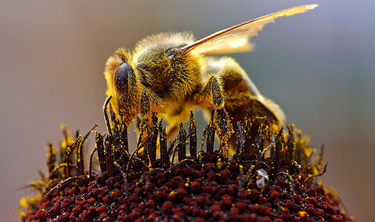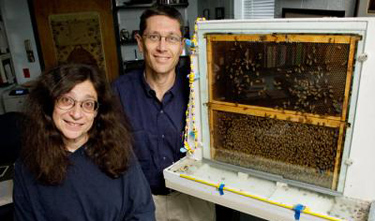Scientists discover possible cause for American honeybee collapse
 Invertebrates
Invertebrates Scientists have made a dramatic discovery of the potential cause of colony collapse disorder - a mysterious malady that in 2007-2008 killed off more than a third of commercial honeybees in the U.S. Their findings are the first to identify a single, objective molecular marker of the disorder, and to propose a data-driven hypothesis to explain the mysterious disappearance of American honeybees.The researchers found that bees from hives affliced by colony collapse disorder (CCD) show abnormalities in their RNA which may make them susceptible to a variety of secondary pathogens.
 Honey bee collecting pollen. Image credit, Jon Sullivan.The research builds on data from the honeybee genome project, which was completed in October 2006, less than a month before the first reports of colony collapse disorder began to circulate. In the new study, scientists from the University of Illinois and the Department of Agriculture utilized the genome and a genome-based tool, the microarray, to look for differences in gene expression in the guys of healthy honeybees and in those from hives afflicted by CCD.
Honey bee collecting pollen. Image credit, Jon Sullivan.The research builds on data from the honeybee genome project, which was completed in October 2006, less than a month before the first reports of colony collapse disorder began to circulate. In the new study, scientists from the University of Illinois and the Department of Agriculture utilized the genome and a genome-based tool, the microarray, to look for differences in gene expression in the guys of healthy honeybees and in those from hives afflicted by CCD.
Reed Johnson, a University of Illinois doctoral student in entomology and first author on the study, noticed that the microarrays were turning up large quantities of fragmented ribosomal RNA (rRNA) in the bees affected by CCD. Ribosomes are the factories in which proteins are made, but Johnson observed that this rRNA contained adenosine-rich sequences not seen in normal ribosomes. This condition otherwise known as "polyadenylation" is believed to be a sign of ribosome degradation. According to study co-author, Gene Robinson,
"Microarrays for other organisms also contain these mysterious pieces of ribosomal RNA, for reasons that are not yet altogether clear. But comparisons of healthy bees and bees from hives afflicted with CCD showed that the fragments were present at a much higher frequency in the CCD bees"
 Professors May Berenbaum and Gene Robinson, University of Illinois at Urbana-Champaign. Photo credit, L. Brian Stauffer, U. of I. News Bureau.
Professors May Berenbaum and Gene Robinson, University of Illinois at Urbana-Champaign. Photo credit, L. Brian Stauffer, U. of I. News Bureau.
The researchers looked at the pathogens of healthy bees and bees from hives affected by CCD and they saw that the CCD bees suffered a relatively high number of infections with picoma-like viruses that attack the ribosome. These viruses take over the cellular machinery to manufacture only viral proteins. The list of picorna-like viruses that afflict honey bees is long and includes Israeli acute paralysis virus, which was once suspected of being the primary cause of CCD.
Many potential causes have been implicated in the hunt for a cause of CCD, from nutritional deficiencies to exposure to genetically modified plants or pesticides. For example, a recent study by an international team of scientists quantified more than 200 pathogens affecting CCD honeybees, including the presence of parasites such as varroa and tracheal mites; infection by bacteria, viruses and fungi; pesticide levels; nutritional factors; and bee physiology. According May Berenbaum co-author of the new study,
"The loss of ribosomal function would explain many of the phenomena associated with CCD,. If your ribosome is compromised, then you can't respond to pesticides, you can't respond to fungal infections or bacteria or inadequate nutrition because the ribosome is central to the survival of any organism. You need proteins to survive."
The scientists suspect that the varroa mite, a carrier of picorna-like viruses may act as a tipping factor leading to ribosome breakdown. The mite is believed to have killed off a significant number of honeybees after it was accidentally introduced to the U.S. in 1986. According to Robinson,
"All of these influences, along with the practice of carting bees around the country for pollination services, are significant stressors on the bees, a heavy burden that would be amplified by a loss of ribosomal function"




Reader Comments